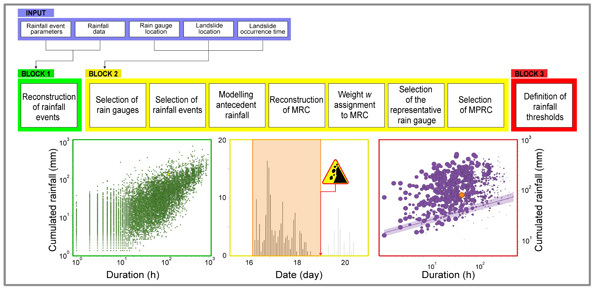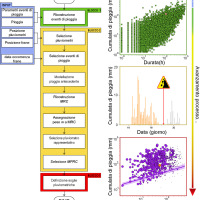How to define rainfall thresholds automatically
How to automatically define the rainfall events and the triggering conditions responsible for the landslides

The empirical rainfall thresholds while representing a useful approach used to forecast landslide occurrence in wide areas, are affected by several uncertainties related to the rainfall and the landslide information accuracy, the reconstruction of the rainfall events responsible for the failure, and the method to calculate the thresholds. Definition of the rainfall conditions responsible for landslides is a crucial issue and may contribute to reduce landslide risk but the criteria for identify the rainfall conditions that could initiate slope failures are still lacking or uncertain. Furthermore, expert investigators usually perform the reconstruction of rainfall events manually increasing uncertainty in the use of non-objective procedures. To solve these problems, we developed a tool named CTRL-T (Calculation of Thresholds for Rainfall-induced Landslides-Tool) that automatically and objectively reconstructs rainfall events and the triggering conditions responsible for the failure, and calculates rainfall thresholds at different exceedance probabilities adopting a frequentist approach that allows the objective and reproducible definition of empirical cumulated event rainfall-rainfall duration thresholds and their associated uncertainties.
CTRL-T was implemented using the R open-source software (www.r-project.org).The structure of the tool consists of three distinct blocks The first operates the reconstruction of rainfall events in terms of duration (D, in h) and cumulated event rainfall (E, in mm) using rainfall series and several parameters to account for different seasonal and climatic settings. Rainfall event parameters were calibrated adopting the monthly soil water balance model and evapotranspiration analysis. The second block performs the selection of the rain gauge representative for the landslide, the modeling of the antecedent rainfall, and the reconstruction of single or multiple rainfall conditions (MRC) likely responsible for the failures (associating a probability to each condition). The third block calculates the rainfall thresholds using the multiple rainfall conditions or the condition with the maximum probability (MPRC) for each failure. The rainfall event parameters, rainfall data, rain gauge location, landslide location and landslide occurrence time represent the input data used by CTRL-T.
Results
The definition of reliable and accurate rainfall thresholds poses several critical issues and sources of subjectivity. The use of a standardized and automatized procedure for the reconstruction of the rainfall conditions responsible for failures and for threshold calculation is necessary for enhancing the objectivity and reproducibility of the thresholds, especially for thresholds to be used in landslide early warning systems.
CTRL-T using continuous rainfall measurements, and landslide information, provides to (1) reconstruct rainfall events; (2) select automatically the representative rain gauges; (3) identify multiple rainfall conditions responsible for the failure in terms of D and E, modelling the cumulated event rainfall; (4) attribute a probability to each rainfall condition; and (5) calculate probabilistic rainfall thresholds and their associated uncertainties. The main novelties concern (i) the automatic selection of the representative rain gauge that is chosen by analyzing the distance between the rain gauge and the landslide and the characteristics of the rainfall events recorded by the station, and (ii) the assignment of a probability to the single or multiple rainfall conditions responsible for the landslide.
In addition, CTRL-T incorporates the procedures to calculate objective and reproducible thresholds. The use of CTRL-T standardizes and accelerates considerably the slow and tedious process of the reconstruction of the rainfall events and reduces the subjectivity inherent in the manual treatment of the data.
CTRL-T allows the possibility of a periodic and reproducible update of the thresholds and has a positive impact on the application of thresholds in early warning systems for operational landslide forecasting.
The frequentist method and CTRL-T have been widely adopted and largely used in the scientific community interested in operational landslide prediction.
Granting institutions
This work was financially supported by the Italian national Department for Civil Protection (DPC) (Accordi di Collaborazione 2014, 2015, 2016), that also provided access to the rainfall database.
To know more
Melillo M., Brunetti M. T., Peruccacci S., Gariano S. L., Roccati A., Guzzetti F. (2018). A tool for the automatic calculation of rainfall thresholds for landslide occurrence. Environmental Modelling & Software, 105, 230–243. doi:10.1016/j.envsoft.2018.03.024
https://doi.org/10.5281/zenodo.4533719
https://doi.org/10.5194/hess-25-3267-2021
https://doi.org/10.5194/nhess-20-2307-2020
https://doi.org/10.1007/s10064-018-1415-2
https://doi.org/10.3390/w12051449
About the tool:
“A tool for the automatic calculation of rainfall thresholds for landslide occurrence” M. Melillo, M. T. Brunetti, S. Peruccacci, S. L. Gariano, A. Roccati, F. Guzzetti.
https://doi.org/10.1016/j.envsoft.2018.03.024
On the frequentist method:
“Rainfall thresholds for the possible occurrence of landslides in Italy” M. T. Brunetti, S. Peruccacci, M. Rossi, S. Luciani, D. Valigi, F. Guzzetti.
https://doi.org/10.5194/nhess-10-447-2010
“Lithological and seasonal control on rainfall thresholds for the possible initiation of landslides in central Italy”
S. Peruccacci, M.T. Brunetti, S. Luciani, C. Vennari, F. Guzzetti
https://doi.org/10.1016/j.geomorph.2011.10.005




 Contact person: massimo melillo -
Contact person: massimo melillo -